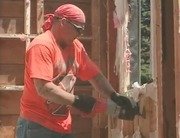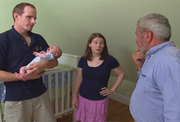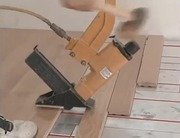Hi, I'm Bob Vila.
Welcome to the show.
We're remodeling a house here, where we are getting a room, a nursery, ready for a new baby.
And today we got some very interesting stuff to discuss.
We're putting in sound attenuation insulation which will make the nursery nice and snug and quiet.
Also, a new type of ceiling that helps with that job as well, by absorbing a lot of sound.
And we'll also be showing you all about how to paint the nursery using the right kinds of paints and the right techniques.
Stick around.
This is our third visit to our nursery project here in Melrose, Massachusetts.
Where a young couple have bought their first home, a two family home.
So.that
the rental income helps defray the cost of the mortgage and they're busy remodeling some bathrooms and a bedroom getting ready for the first babies arrival any day now.
Nick and Maggie live on the second and third floor of this big 1895 house.
They've already insulated the roof up above there to help defray the cost of heating in our tough New England winters.
Now it's time to talk about insulating the interior walls for sound attenuation, because after all, baby needs a quiet environment , as well as a warm one.
Arlene Bronza has a PhD in child psychology and you are visiting us here at this project.
And I guess one of the, the things that would concern us is why is it important to have peace and quiet around the nursery.
Well, a child has to sleep and children really find it much easier to fall asleep in a quiet room.
Now you might say to me, "But the child is gonna make some sounds?"
Yeah, those are the sounds for parents and when the child makes sounds particularly an infant.
it's usually a cry because the child's wet, the child's hungry, the child is uncomfortable.
And those are cues that parents have to listen to and attend to and quiet the child .
But when the child has to fall asleep, it's important for the child's development that the child has a good night's sleep.
Even though it's broken up by feeding period.
Sure.
But they need to sleep.
Development occurs while the child's asleep.
But some would make the observation that many babies come into a household where there's already one or two, or thanks to wonder drugs, maybe six other kids that are older and that are making a racket around the house.
Isn't it important also for a baby to, kind of, get accustomed to that buzz and that level of noise?
You're talking about the child getting accustomed, but the baby is still a baby.
We're talking about a newborn.
Infants.
We're talking about an infant form zero to six or seven months of age.
When you're putting a child to sleep, it's generally better to have a quieter environment for that child.
That's why they call them lullabies, right?
That's a very good word.
But then there's also something else.
It think what it also says, in terms of the environment of the household, that the parent that understands that the child needs some quiet when the child is very young will also understand that for that child's mental and physical development there will be times when quiet will help that child to study, to learn, to read.
Quiet is not silence.
It's just quiet.
We can still hear the breeze, we can still hear a leaf.
And the child will get of course, want those sounds, those are wonderful sounds, but when it's just an infant that we're talking about, we're really focusing on rest, and that is definitely aided by quiet .
Arlene thank you for those insights.
Thank you.
Now as part of doing this to the environment Owens Corning has come up with a whole concept of the Quiet Zone.
And Harry Alter was here just a few days ago getting started with some of the measures that we're taking to assure that the nursery is a quiet zone.
First of all, the first thing to have is long sleeved shirts.
Alright, after that you want to have gloves to be able handle the the fiberglass with.
Next is goggles, a hat, and then last of all, you need a dust mask.
It's just a pretty simple process.
You just take the batt and put it into the cavity, and tuck it in as you go.
Alright, now all the batts have, with the faced batts, you have a little flange here.
You basically staple that about every eight inches.
You just want to, basically, let it lie in the cavity.
Make sure it's in.
Then when you get to the the outlet, you can basically, basically you kind of mark where the outlet is.
So then you can take this off, and cut it out.
OK.
Then you stuff it back in, go around the outlet .
Again, making sure that you're not compressing the bat.
What you do, is you just split the bat.
And you can stuff this right behind the wiring, and bring it down.
Alright, so you Got the wiring in there now and then you bring the battery over it.
So Harry the thing I noticed right away is that you've done a very, very careful and meticulous job of installing the product here.
So that there aren't any gaps and it really fills in the cavity in between the studs.
That's important I guess right?
Yea make sure all the studs cavities are filled, and then after you do that, obviously, then you want to start looking for any gaps and cracks in the wall, 'cause that's an easy path for noise to get through.
OK.
And that's when we start looking at caulk.
Is this fiber glass different from what we put in the side wall to keep the cold out?
Well there's a lot of different densities of fiber glass, alright, and this is a one density that is a light weight density and it's designed specifically for acoustics.
It's not used thermally.
It's not tested thermally.
We do all of our testing specifically for its ability to reduce noise in floors or ceilings.
To reduce noise.
transmission.
Okay.
So, what's the caulking gun for?
I've got a Kryson acoustic ceiling, and this is a siliconized acrylic.
And it's designed to be flexible over time, so that it doesn't harden.
And we use it to seal up the gaps and cracks in the wall that can happen at the base plate, where the base plate meets the floor, and also around the outlets .
And that will happen after the gypsum goes up.
And for this instance, I'm going to be sealing up the gap where the existing ceiling meets this top plate.
Just to make sure everything is sealed up.
So, all the way across from that corner and then down to the bottom , you want to provide a bead of this.
Yeah.
Okay.
Thanks, Eric.
Thank you.






